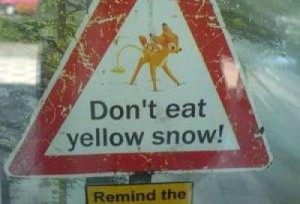Jeff S. Gaffney, a professor of chemistry at the University of Arkansas at Little Rock, told NPR that if we were to package snow and put it on grocery store shelves, the ingredient list would be, “Primarily water,” but also “various and sundry things depending on where it [comes from]” — things like sulphates, nitrates, formaldehyde or mercury.
 As it falls through the sky, snow, with its intricate latticework, forms a sort of net for catching pollutants that may be in the atmosphere. The most common is black carbon, or soot, released by coal-fired plants and wood-burning stoves.
As it falls through the sky, snow, with its intricate latticework, forms a sort of net for catching pollutants that may be in the atmosphere. The most common is black carbon, or soot, released by coal-fired plants and wood-burning stoves.
That’s why John Pomeroy, a researcher who studies water resources and climate change at the University of Saskatchewan, suggests it’s better to wait until a few hours into the snowfall to gather your fresh catch. Snow acts like a kind of atmospheric “scrubbing brush,” he explains. The longer the snow falls, the lower the pollution levels in the air, and thus in the snow.
But even if you start to collect as soon as it begins to flurry, Gaffney reassures me that contaminants in snow are “all at levels well below toxic.”


.jpg) The National Hockey League season debuted on Thursday, and all 30 teams played on Saturday, including games in Finland and Sweden, the later featuring a ceremonial puck dropping by one of
The National Hockey League season debuted on Thursday, and all 30 teams played on Saturday, including games in Finland and Sweden, the later featuring a ceremonial puck dropping by one of  And Ramsey does a full Baby Huey by kicking a garbage can; that’s what happens when the yelling doesn’t work.
And Ramsey does a full Baby Huey by kicking a garbage can; that’s what happens when the yelling doesn’t work. Frank Zappa
Frank Zappa And parents who warn their kids not to eat dirty snow (especially the yellow variety) are left wondering whether to stop them from tasting the new-fallen stuff, too, because of Pseudomonas syringae, bacteria that can cause diseases in bean and tomato plants.
And parents who warn their kids not to eat dirty snow (especially the yellow variety) are left wondering whether to stop them from tasting the new-fallen stuff, too, because of Pseudomonas syringae, bacteria that can cause diseases in bean and tomato plants.